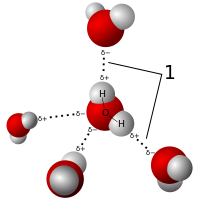
Photo from wikipedia
Using the hybrid density functional theory (DFT) computational approach, we examine the effect of hydrogen passivation and isovalent doping on the vacancy(V n )-oxygen interstitial(O i ), i.e., V n… Click to show full abstract
Using the hybrid density functional theory (DFT) computational approach, we examine the effect of hydrogen passivation and isovalent doping on the vacancy(V n )-oxygen interstitial(O i ), i.e., V n -O m i ( n , m = 0,1,2) defect complexes in silicon. Specifically, we study the structural properties, relative stability and defect levels induced by the V, V 2 , VO i , V 2 O i VO 2 i defect complexes. We found that hydrogen passivation improve the electrical activity of silicon vacancy and divacancy, but has negative or undesirable effect on the electrical activity of VO i , V 2 O i VO 2 i defect complexes. To remove the negative effect of hydrogen passivation, isovalent doping of VO i , V 2 O i VO 2 i defect complexes with each of Ge, Sn and Pb is carried out. This is found to improve the electrical activity of the defect complexes by shifting the defect-induced acceptor and shallow donor levels deep into the valence and the conduction bands, respectively. Our work emphasizes the importance of isovalent doping in improving the electrical activity of silicon containing hydrogen and vacancy-oxygen defect complexes.
Journal Title: Silicon
Year Published: 2020
Link to full text (if available)
Share on Social Media: Sign Up to like & get
recommendations!